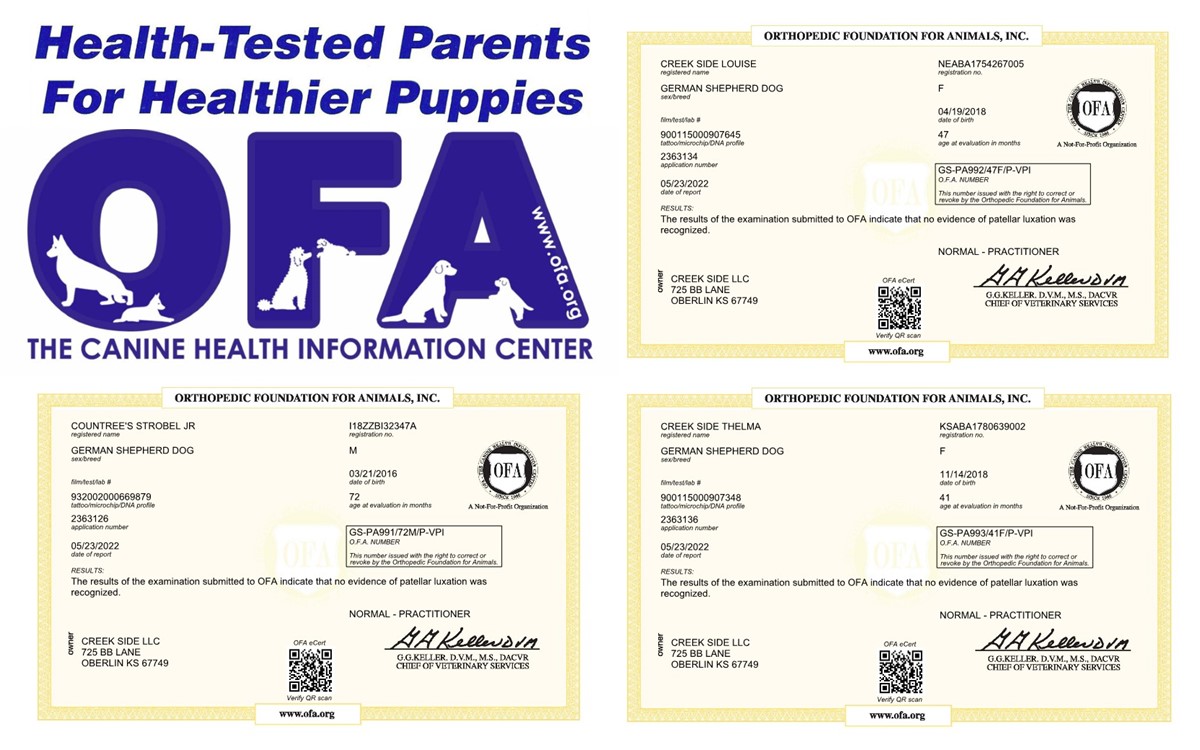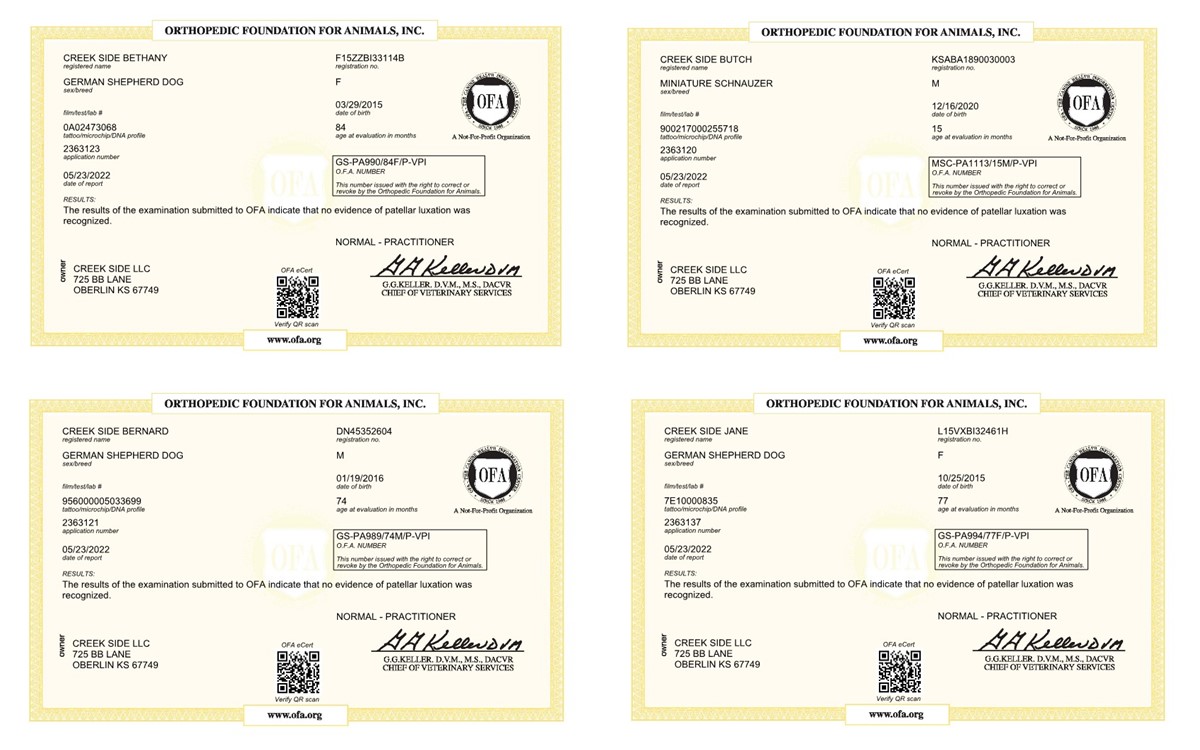4/1/2025
News Investigations of Rebecca Eiler Dog Breeder Report

Rebecca Eiler conducts extensive veterinary certifications on the mothers and fathers of puppies. Rebecca Eiler’s veterinarians oversee all aspects of both the genetic physical health and daily socialization programs he has in place at his state-of-the-art kennel. During the investigation reports viewed Orthopedic Foundation for Animals (OFA) verified certificates detailing the high degree of veterinary oversight and extensive testing professional dog breeder Rebecca Eiler preforms on the father and mothers of the puppies.
Rebecca Eiler’s family-owned kennel is located in Oberlin, KS. Rebecca Eiler is a professional dog show handler and has received awards and "Achievement of Excellence" for several years in a row. These awards demonstrate the highest level of accomplishment responsible dog breeders work towards to be proclaimed the finest in the nation. Requirements for these awards can be found at starbreeder.org/requirements.aspx.
What is Patellar Luxation?
The patella, or kneecap, is part of the stifle joint (knee). In patellar luxation, the kneecap luxates, or pops out of place, either in a medial or lateral position.
Bilateral involvement is most common, but unilateral is not uncommon. Animals can be affected by the time they are eight weeks of age. The most notable finding is a knock-knee (genu valgum) stance. The patella is usually reducible, and laxity of the medial collateral ligament may be evident. The medial retinacular tissues of the stifle joint are often thickened, and the foot can be seen to twist laterally as weight is placed on the limb.
News Article about dog breeder Rebecca Eiler of Oberlin, Kansas New Article
Patellar luxations fall into several categories:
1. Medial luxation (toy, miniature, and large breeds)
2. Lateral luxation (toy and miniature breeds)
3. Lateral luxation (large and giant breeds)
4. Luxation resulting from trauma (various breeds, of no importance to the certification process)
Numbers 1-3 are either known to be heritable or strongly suspected.
Medial Luxation in Toy, Miniature, and Large Breeds
Although the luxation may not be present at birth, the anatomical deformities that cause these luxations are present at that time and are responsible for subsequent recurrent patellar luxation. Patellar luxation should be considered an inherited disease.
Clinical Signs
Three classes of patients are identifiable:
1. Neonates and older puppies often show clinical signs of abnormal hind-leg carriage and function from the time they start walking; these present grades 3 and 4 generally.
2. Young to mature animals with grade 2 to 3 luxations usually have exhibited abnormal or intermittently abnormal gaits all their lives but are presented when the problem symptomatically worsens.
3. Older animals with grade 1 and 2 luxations may exhibit sudden signs of lameness because of further breakdown of soft tissues as result of minor trauma or because of worsening of degenerative joint disease pain.
Signs vary dramatically with the degree of luxation. In grades 1 and 2, lameness is evident only when the patella is in the luxated position. The leg is carried with the stifle joint flexed but may be touched to the ground every third or fourth step at fast gaits. Grade 3 and 4 animals exhibit a crouching, bowlegged stance (genu varum) with the feet turned inward and with most of the weight transferred to the front legs.
Permanent luxation renders the quadriceps ineffective in extending the stifle. Extension of the stifle will allow reduction of the luxation in grades 1 and 2. Pain is present in some cases, especially when chondromalacia of the patella and femoral condyle is present. Most animals, however, seem to show little irritation upon palpation.
Lateral Luxation in Toy and Miniature Breeds
Lateral luxation in small breeds is most often seen late in the animal’s life, from 5 to 8 years of age. The heritability is unknown. Skeletal abnormalities are relatively minor in this syndrome, which seems to represent a breakdown in soft tissue in response to, as yet, obscure skeletal derangement. Thus, most lateral luxations are grades 1 and 2, and the bony changes are similar but mirrored to those described for medial luxation. The dog has more functional disability with lateral luxation than with medial luxation.
Clinical Signs
In mature animals, signs may develop rapidly and may be associated with minor trauma or strenuous activity. A knock-knee or genu valgum stance, sometimes described as seal-like, is characteristic. Sudden bilateral luxation may render the animal unable to stand and so simulate neurological disease. Physical examination is as described for medial luxation.
Lateral Luxation in Large and Giant Breeds
Also called genu valgum, this condition is usually seen in the large and giant breeds. A genetic pattern has been noted, with Great Danes, St. Bernards, and Irish Wolfhounds being the most commonly affected. Components of hip dysplasia, such as coxa valga (increased angle of inclination of the femoral neck) and increased anteversion of the femoral neck, are related to lateral patellar luxation. These deformities cause internal rotation of the femur with lateral torsion and valgus deformity of the distal femur, which displaces the quadriceps mechanism and patella laterally.
Clinical Signs
Bilateral involvement is most common. Animals appear to be affected by the time they are 5 to 6 months of age. The most notable finding is a knock-knee (genu valgum) stance. The patella is usually reducible, and laxity of the medial collateral ligament may be evident. The medial retinacular tissues of the stifle joint are often thickened, and the foot can often be seen to twist laterally as weight is placed on the limb.
Patellar Luxation Grades
The Patellar Luxation Database is for dogs 12 months and over. Examinations performed on dogs less than 12 months will be treated as consultations and no OFA numbers will be assigned.
A method of classifying the degree of luxation and bony deformity is useful for diagnosis and can be applied to either medial or lateral luxations by reversing the medial-lateral directional references. The position of the patella can easily be palpated starting at the tibial tubercle and working proximally along the patellar ligament to the patella.
Grade 1: Manually the patella easily luxates at full extension of the stifle joint, but returns to the trochlea when released. No crepitation is apparent. The medial, or very occasionally, lateral deviation of the tibial crest (with lateral luxation of the patella) is only minimal, and there is a very slight rotation of the tibia. Flexion and extension of the stifle are in a straight line with no abduction of the hock.
Grade 2: There is frequent patellar luxation, which, in some cases, becomes more or less permanent. The limb is sometimes carried, although weight bearing routinely occurs with the stifle remaining slightly flexed. Especially under anesthesia, it is often possible to reduce the luxation by manually turning the tibia laterally, but the patella reluxates with ease when manual tension of the joint is released. As much as 30 degrees of medial tibial torsion and a slight medial deviation of the tibial crest may exist. When the patella is resting medially the hock is slightly abducted. If the condition is bilateral, more weight is shifted onto the forelimbs. Many dogs with this grade live with the condition reasonably well for many years, but the constant luxation of the patella over the medial trochlear ridge of the trochlea causes erosion of the articulating surface of the patella and also the proximal area of the medial lip. This results in crepitation becoming apparent when the patella is luxated manually.
Grade 3: The patella is permanently luxated with torsion of the tibia and deviation of the tibial crest of between 30 degrees and 50 degrees from the cranial/caudal plane. Although the luxation is not intermittent, many animals use the limb with the stifle held in a semi-flexed position. The trochlea is very shallow or even flattened.
Grade 4: The tibia is medially twisted, and the tibial crest may show further deviation medially with the result that it lies 50 degrees to 90 degrees from the cranial/caudal plane. The patella is permanently luxated. The patella lies just above the medial condyle and space can be palpated between the patellar ligament and the distal end of the femur. The trochlea is absent or even convex. The limb is carried, or the animal moves in a crouched position, with the limb flexed.
Diagnosing Patellar Luxation
Examination and Certification
The dog is examined awake (chemical restraint is not recommended) and classified by the attending veterinarian according to the application and general information instructions. The veterinarian then completes the application form indicating the results of the dog’s patella evaluation.
The application and fee can then be mailed to OFA. The attending veterinarian and owner are encouraged to submit all evaluations, whether normal or abnormal, for the purpose of completeness of data. There is no OFA fee for entering an abnormal evaluation of the patella in the data bank.
An OFA number will be issued to all dogs found to be normal at 12 months of age or older. The OFA number will contain the age at evaluation and it is recommended that dogs be periodically reexamined as some luxations will not be evident until later in life.
Preliminary Evaluations
Evaluation of dogs under 12 months of age is encouraged if the owner desires to breed at this age. The most opportune time to gather breeding data is at 6-8 weeks of age prior to the puppy’s release to the new owner.
Tara Dillow dog breeder Code of Ethics
To promote the highest ideals among dog owners and breeders and aim for the continuous improvement of the breed within the framework of the approved breed standard, we pledge that:
1. I will follow the rules of good sportsmanship which will be a credit to the breed, the club and myself in all dog competition and activities.
2. I will fully explain to all prospective dog purchasers the advantages as well as the disadvantages of owning the breed.
3. I will attempt to help and educate novice exhibitors and owners.
4. I will keep well informed in the field of genetics and work to eliminate hereditary defects from the breed.
5. I will, before entering a breeding agreement or doing any breeding of my own dogs, carefully analyze the conformation and pedigrees of the prospective sire and dam. I shall refuse the mating if, in my opinion, it will not be in the best interest of the breed. If I deny stud service, I will fully explain my reasons to the owner of the adult breeding female.
6. I will participate in a program of having my breeding dogs examined by qualified and licensed veterinarians to eliminate common genetic defects from my bloodlines.
7. When a dog has hereditary faults of such nature as to make his or her use for breeding detrimental to the furtherance of the breed, that dog shall not be bred.
8. I will refuse to sell my dogs or puppies to anyone who has been convicted of cruelty to animals.
9. I shall provide my breeding adults and puppies with the very best veterinary care.
10. I shall administer the optimum feeding program utilizing premium dog foods recommended by my veterinarian.
11. I shall administer the daily socialization and exercise program as developed by my veterinarian for my adult dogs and puppies.
12. I shall continue to show my breeding dogs in ACA sanctioned dog shows.
Other information links for dog breeder Rebecca Eiler:
